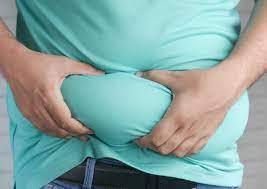Key Facts
Excessive fat around your body specially in belly area and other vital organs knows as Visceral Fat, it is also consider as Toxic Fat.
Visceral fat is bad for our overall health, It cause many alarming health problems like heart attack, diabetes, high blood pressure and even cancer.
Visceral can be caused by follow a unhealthy diet and by overacting, also If you intake excessive calories and not even move.
If a female waist size is 80cm plus or and a male waist is 94cm plus then It means you are over visceral fat.
How to lose Visceral Fat? The answer is In order to reduce visceral fat, all you need to do is to follow a healthy and balanced diet and do exercises regularly.
Visceral Fat: What it is?
Visceral body fat is a type of fat that gathers with the abdominal cavity, which is nearby vital organs like the liver, intestines and pancreas. Subcutaneous fat which is under our skin and visible but this visceral body fat is hidden and can’t be easily seen by our eyes as It is not visible. While some fats are normal in our body, visceral fat especially when it is in excessive amounts can lead you to various health concerns like heart attack, diabetes and metabolic syndrome.
There are some main reasons why visceral fat is dangerous for your health when it reaches the critical organs and releases inflammatory substances in the bloodstream, which later create problems for body function as Visceral fat affects your metabolism, insulin sensitivity and even hormone balance. In this article we will talk about what is visceral fat? What are the causes of it, how it affects our body and how to lose visceral fat so lets start.
Main Causes of Visceral Fat
The main causes of visceral fat depends upon various factors like poor diet, genetic influences, hormonal imbalance and not moving like not doing any kind of physical activity. Here are the key elements let’s discuss in detail.
- Poor Diet: When you don’t follow any diet and consume a lot of processed foods, sugary items, unhealthy fats and refined carbohydrates, It can lead you to excessive visceral fat. As these foods increase inflammation, insulin sensitivity, make an easy way for visceral fat to reach and settle around internal organs which leads to various health concerns like heart problems and diabetes etc.
- Lack of Physical Activity: When you eat a lot of junk, caloric and processed food they all stay in your body and convert into visceral fat which may lead alarming health issues later, the main reason is your poor lifestyle by not doing any physical activity and not even moving after eating anything you are just increasing visceral fat by this. Doing regular physical activities like jogging, running and gyming can help you to reduce visceral fat.
- Genetics: Some people are genetically predisposed to store fat in the abdominal areas like if you have a history of obesity and digestive issues, metabolic condition you may have more chances to have visceral fat.
- Hormonal Changes: When it comes to visceral fat, hormonal changes also play an important role. These hormonal changes can be seen specially in females during their period cycle which leads to visceral fat increase. A decrease in estrogen and changes in other hormones can cause fat to shift from the hips and thighs to the abdomen. You can clearly notice a heavy fat around your hip and thighs that is visceral fat.
- Chronic Stress: Another reason for visceral fat is stress, as stress plays an important role in production of a hormone called cortisol, It promotes fat storage especially in the abdominal area.
- Sleep Deprivation: Other reasons for visceral fat are irregular and poor sleep patterns. It leads to body disturbance, weight gain and even increased hunger hormones which result in visceral fat, It can be clearly seen around the belly.
- Aging: As people age, their metabolism naturally slows down, and they tend to lose muscle mass. This can make it easier for visceral fat to accumulate, particularly if a person becomes less active.
Common Areas for Visceral Fat Accumulation:
- Abdomen
- Around the Organs
- Under the Diaphragm
- Inside the Peritoneal Cavity
Major Health Issues cause by Visceral Fat
Visceral fat is linked to several serious health risks, many of which can significantly impact long-term well-being. Some of the most notable health risks associated with visceral fat include:
Visceral fat can lead to inflammation and higher levels of LDL (bad) cholesterol and triglycerides, these both elements contribute to plaque making in the areas like arteries, which results in heart attack, heart failure and strokes.
Excessive Visceral fat is bad for overall health, It can cause insulin sensitivity which leads to increase in blood sugar levels that may later develop type-2 diabetes.
Like we discussed earlier Visceral fat increases inflammation, which can lead to higher blood pressure (hypertension), which increases risk of heart problems like heart attack.
Visceral fat accumulation can contribute to the development of non-alcoholic fatty liver disease (NAFLD), which occurs when fat builds up in the liver without alcohol consumption. Over time, this can lead to liver inflammation and even cirrhosis.
Visceral fat also contributes to sleep apnea. Excessive fat around the abdomen area can build pressure in the diaphragm, which leads to breathing difficulties that result in sleeping problems like irregular sleep etc.
According to some studies, Visceral fat also leads to an increased risk of multiple cancers like breast, colorectal, and pancreatic cancer. The main reason is that a substance released by visceral fat contributes to developing gland-like cancer in the body.
Overweight and inflammation in the body is linked with visceral fat contribute to strain on the joints, particularly the knees and hips, which leads to Osteoarthritis.
How to lose Visceral Fat: Things You Should Do
Reducing visceral fat is key to improving overall health and reducing the risk of chronic diseases. Here are some effective steps you can take:
Eat More Anti-Inflammatory Foods
Diet plays an important role for overall health and well being. In order to stay away from Visceral fat you need to add anti-inflammatory foods like leafy greens, fatty fish (such as salmon), nuts, seeds, and fruits. These foods help in reducing inflammation. Chronic Inflammation is linked to visceral fat, so by focusing on anti-inflammatory food and incorporating them in your diet helps you to achieve better health goals.
Consume Plenty of Protein
Protein is not only good for muscle repairing and growth but also helps in reducing body fat. Eating high-quality protein sources like lean protein, meat, eggs and other dairy products can help in increasing a feeling of fullness which leads to hunger reduction and boost metabolism which results in reducing visceral fat in your body.
Focus on Fiber
Foods that are rich in fiber like oats, beans, fruits and vegetables can help in regulating blood sugar levels, support gut health and reduce fat accumulation which results in visceral fat reduction.
Eat Frequently
Instead of consuming large portions of a meal, try to consume small portions throughout the day. This can help to regulate blood sugar level, reduce hunger which leads to balanced eating and maintain a healthy metabolism. Eating more frequently with healthy snacks can prevent hunger and help you avoid unhealthy food choices that promote fat storage.
Exercise Regularly
Physical activities play an important role when it comes to weight loss and healthy life. If you eat excessive food but don’t do any physical activity or not even more it will result in visceral fat. In order to avoid risk of visceral fat production all you need to do is aerobic exercises (like walking, running, or cycling) and strength training. Try to do 30 minutes a day or at least 150 minutes of exercise each week. Exercise helps increase energy expenditure, improves metabolism, and directly targets fat stores, including visceral fat.
Consider Lifestyle Factors
Poor lifestyle can lead to visceral fat. In order to reduce visceral fat all you need to do is follow a healthy lifestyle routine by doing stress management, taking good sleep and eliminating intake of alcohol. Try to sleep for maximum 7 to 9 hours at night this results in regulating hormones, removing stress and a good metabolism that leads to fat loss.
How to Measure Visceral fat? Tips and Tricks
Determining if you have visceral fat whether it is in low or high quantity can be a difficult and challenging task as it is hidden inside the abdominal area so it is not visible on the surface. It can be visible if it is excessive in nature but it’s a rare case. However, there are several methods and signs you can use to assess whether you may have an excess of visceral fat:
1. Waist Circumference Measurement
One of the easiest ways to measure visceral fat is to measure your waist circumference. Like for men if waist measurement is greater than 40 inches and in females if it is more than 35 inches it means you have a high level of visceral fat. Although this method doesn’t directly measure visceral fat, it can serve as a useful screening tool.
2. Waist-to-Hip Ratio (WHR)
This ratio compares the circumference of your waist to that of your hips. A higher waist-to-hip ratio indicates a higher risk of visceral fat. The general guidelines are:
- For men: A ratio above 0.90 is considered risky.
- For women: A ratio above 0.85 is considered risky. This measurement provides more context for your body shape and fat distribution.
3. Body Mass Index (BMI)
Since body mass index is not a perfect option for measuring visceral fat, it can give you a general idea about weight gain and obesity. These two elements increase visceral fat. A BMI of 30 or higher means you have obesity and a high risk of visceral fat.
4. Imaging Tests (CT Scan or MRI)
Unlike the BMI, the most accurate and easiest way to measure visceral fat directly is by medical imaging techniques like CT scan (computed tomography) or MRI (magnetic resonance imaging). These imaging tests can help you to measure an accurate amount of visceral fat but these are way too expensive and can’t be easily affordable by everyone. It is also used only in a situation when there is a medical reason.
5. Body Fat Percentage
Body fat percentage is also not accurate every time as it doe not directly measure visceral fat but they can help you to assess overall far levels of the body. Tools like bioelectrical impedance scales, skinfold calipers, or more advanced methods (DEXA scans) can calculate body fat percentage. People with higher body fat percentages may be at greater risk for visceral fat.
6. Signs of Visceral Fat Accumulation
If you don’t want to measure visceral fat by imaging test or measurement tool as we discuss earlier there is another way you can check visceral fat as there are visible sign that indicates excessive visceral fat like heavy hanging belly, swelling around belly, you find difficult to lose body weight even after eating a balanced diet and doing exercises and you may feel heavy, have high blood pressure and high blood sugar level always.
7. Health Indicators
If you’re experiencing symptoms like high blood pressure, elevated cholesterol, or insulin resistance, it could indicate that you have visceral fat. Excess visceral fat often releases inflammatory substances and hormones that negatively affect these systems.
Signs you are losing Visceral Fat?
Losing visceral fat is a long term process, people consider it difficult to do, the signs may not always be immediately obvious as reducing visceral fat is very slow. However, there are several indicators that suggest you may be reducing visceral fat:
- Reduced Waist Circumference.
- Improved Abdominal Firmness.
- Improved Health Markers.
- Increased Energy Levels.
- Better Sleep Quality.
- Improved Digestion.
- Better Physical Performance.
- Visible Reduction in Belly Fat.
- Reduced Inflammation.
- Mental Clarity and Focus.
Conclusion
In conclusion, visceral fat is a dangerous type of fat that lies deep within the abdominal cavity, surrounding vital organs like the liver, pancreas, and intestines. Unlike subcutaneous fat, which is more visible and less harmful, visceral fat has been linked to a variety of serious health conditions such as heart disease, type 2 diabetes, and metabolic syndrome. Its ability to produce harmful hormones and inflammatory substances makes it especially detrimental to overall health.
Also Read: Is Linoleic Acid Bad for You? Understanding Its Impact on Health


